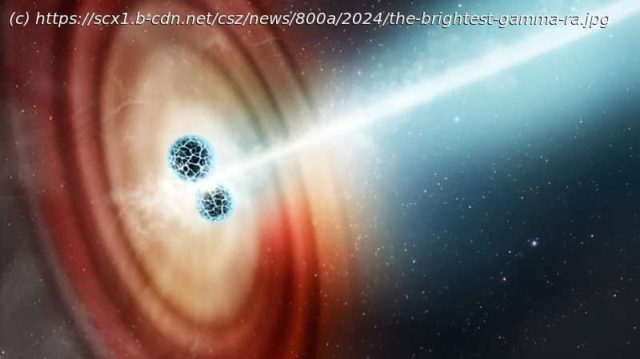After a journey lasting about two billion years, photons from an extremely energetic gamma-ray burst (GRB) struck the sensors on the Neil Gehrels Swift Observatory and the Fermi Gamma-Ray Space Telescope on October 9th, 2022. The GRB lasted seven minutes but was visible for much longer. Even amateur astronomers spotted the powerful burst in visible frequencies.
After a journey lasting about two billion years, photons from an extremely energetic gamma-ray burst (GRB) struck the sensors on the Neil Gehrels Swift Observatory and the Fermi Gamma-Ray Space Telescope on October 9th, 2022. The GRB lasted seven minutes but was visible for much longer. Even amateur astronomers spotted the powerful burst in visible frequencies.
It was so powerful that it affected Earth’s atmosphere, a remarkable feat for something more than two billion light-years away. It’s the brightest GRB ever observed, and since then, astrophysicists have searched for its source.
NASA says GRBs are the most powerful explosions in the universe. They were first detected in the late 1960s by American satellites launched to keep an eye on the USSR. The Americans were concerned that the Russians might keep testing atomic weapons despite signing 1963’s Nuclear Test Ban Treaty.
Now, we detect about one GRB daily, and they’re always in distant galaxies. Astrophysicists struggled to explain them, coming up with different hypotheses. There was so much research into them that by the year 2,000, an average of 1.5 articles on GRBs were published in scientific journals daily.
There were many different proposed causes. Some thought that GRBs could be released when comets collided with neutron stars. Others thought they could come from massive stars collapsing to become black holes. In fact, scientists wondered if quasars, supernovae, pulsars, and even globular clusters could be the cause of GRBs or associated with them somehow.
GRBs are confounding because their light curves are so complex. No two are identical. But astrophysicists made progress, and they’ve learned a few things. Short-duration GRBs are caused by the merger of two neutron stars or the merger of a neutron star and a black hole. Longer-duration GRBs are caused by a massive star collapsing and forming a black hole.
New research in Nature Astronomy examined the ultra-energetic GRB 221009A, dubbed the «B.O.A.T: Brightest Of All Time,» and found something surprising. When it was initially discovered, scientists said it was caused by a massive star collapsing into a black hole. The new research doesn’t contradict that. But it presents a new mystery: why are there no heavy elements in the newly uncovered supernova?
The research is «JWST detection of a supernova associated with GRB 221009A without an r-process signature.» The lead author is Peter Blanchard, a Center for Interdisciplinary Exploration and Research in Astrophysics (CIERA) postdoctoral fellow.
«The GRB was so bright that it obscured any potential supernova signature in the first weeks and months after the burst,» Blanchard said. «At these times, the so-called afterglow of the GRB was like the headlights of a car coming straight at you, preventing you from seeing the car itself. So, we had to wait for it to fade significantly to give us a chance of seeing the supernova.»
«When we confirmed that the GRB was generated by the collapse of a massive star, that gave us the opportunity to test a hypothesis for how some of the heaviest elements in the universe are formed,» said lead author Blanchard.
«We did not see signatures of these heavy elements, suggesting that extremely energetic GRBs like the B.






